CDS-Ltd: Info Systems & Internet Challenges to Privacy & Property
VerifiedAdded on 2023/06/18
|10
|3547
|348
Report
AI Summary
This report examines the challenges contemporary information systems technology and the internet present to the protection of individual privacy and intellectual property. It begins by defining privacy and fair information practices. It then describes why organizations have become dependent on and vulnerable due to information systems, covering topics like spamming, hacking, jamming, malicious software, sniffing, spoofing, and identity theft. The report explores how the internet challenges privacy through website security issues, authentication problems, phishing, and password attacks. Furthermore, it details how tools like informed consent, legislation (including acts like the Federal Trade Commission Act and the Children's Online Privacy Protection Act), industry self-regulation, and technology can help protect individual privacy. Finally, it discusses ways to protect intellectual property rights, concluding with recommendations for mitigating risks. This document is available on Desklib, where students can find a wealth of solved assignments.
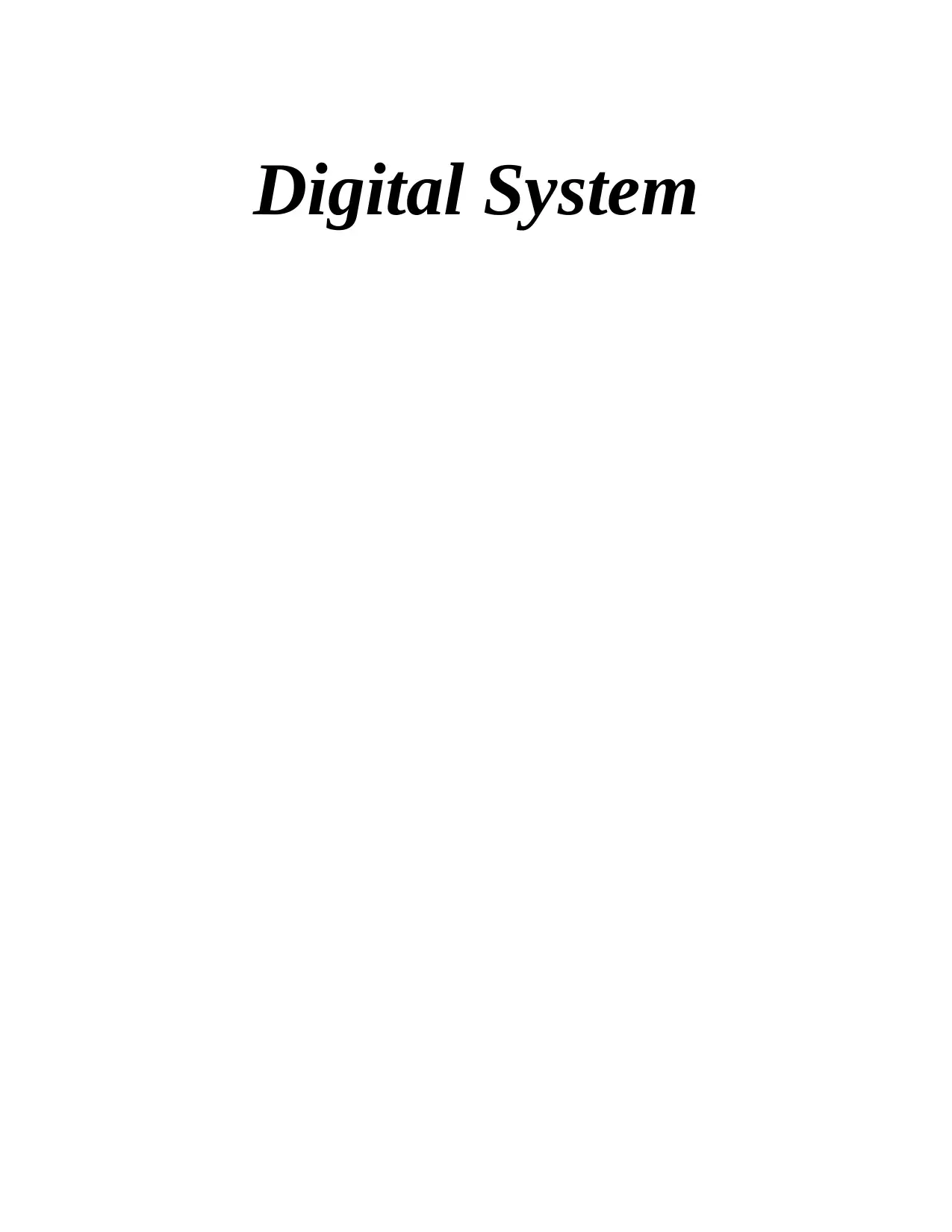
Digital System
Paraphrase This Document
Need a fresh take? Get an instant paraphrase of this document with our AI Paraphraser
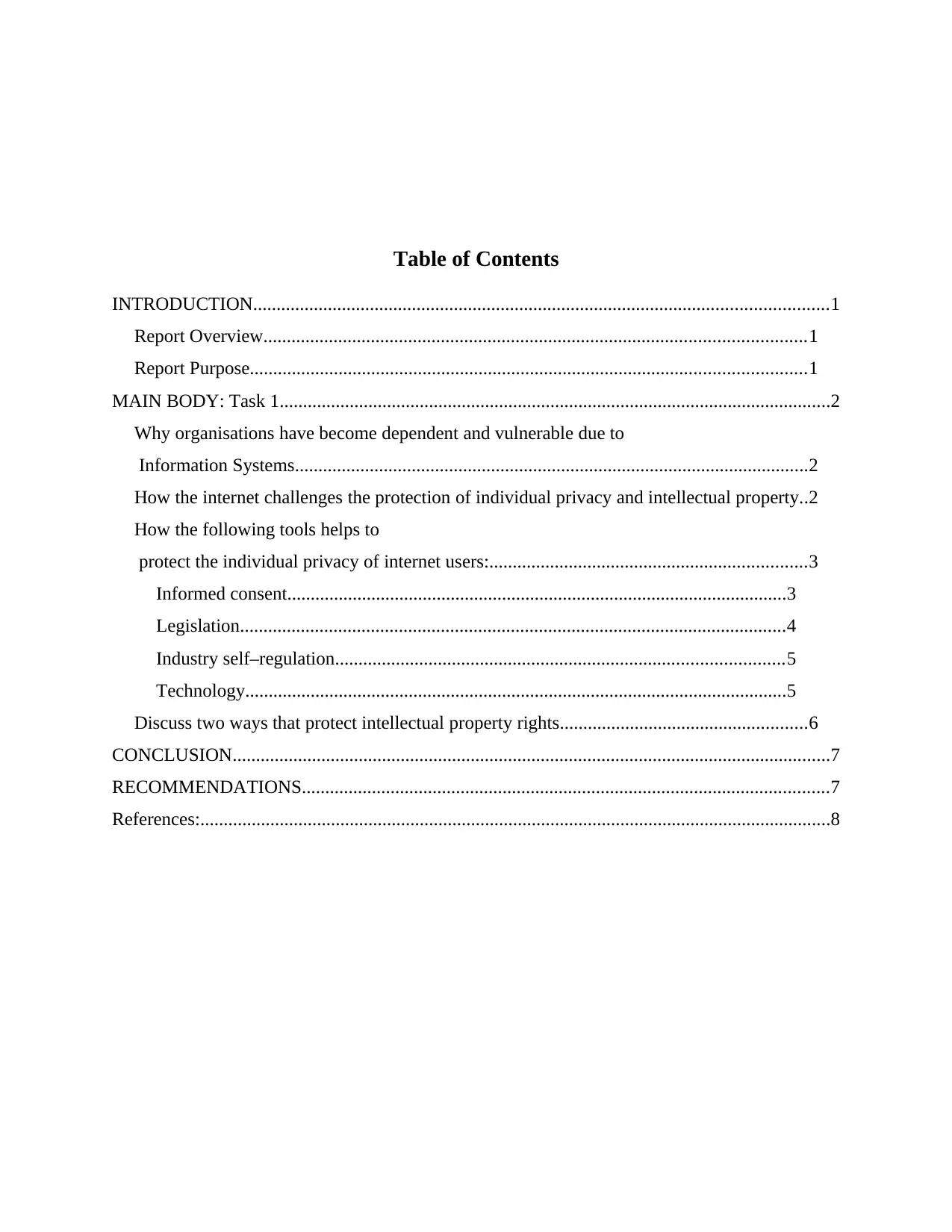
Table of Contents
INTRODUCTION...........................................................................................................................1
Report Overview....................................................................................................................1
Report Purpose.......................................................................................................................1
MAIN BODY: Task 1......................................................................................................................2
Why organisations have become dependent and vulnerable due to
Information Systems..............................................................................................................2
How the internet challenges the protection of individual privacy and intellectual property..2
How the following tools helps to
protect the individual privacy of internet users:....................................................................3
Informed consent...........................................................................................................3
Legislation.....................................................................................................................4
Industry self–regulation................................................................................................5
Technology....................................................................................................................5
Discuss two ways that protect intellectual property rights.....................................................6
CONCLUSION................................................................................................................................7
RECOMMENDATIONS.................................................................................................................7
References:.......................................................................................................................................8
INTRODUCTION...........................................................................................................................1
Report Overview....................................................................................................................1
Report Purpose.......................................................................................................................1
MAIN BODY: Task 1......................................................................................................................2
Why organisations have become dependent and vulnerable due to
Information Systems..............................................................................................................2
How the internet challenges the protection of individual privacy and intellectual property..2
How the following tools helps to
protect the individual privacy of internet users:....................................................................3
Informed consent...........................................................................................................3
Legislation.....................................................................................................................4
Industry self–regulation................................................................................................5
Technology....................................................................................................................5
Discuss two ways that protect intellectual property rights.....................................................6
CONCLUSION................................................................................................................................7
RECOMMENDATIONS.................................................................................................................7
References:.......................................................................................................................................8
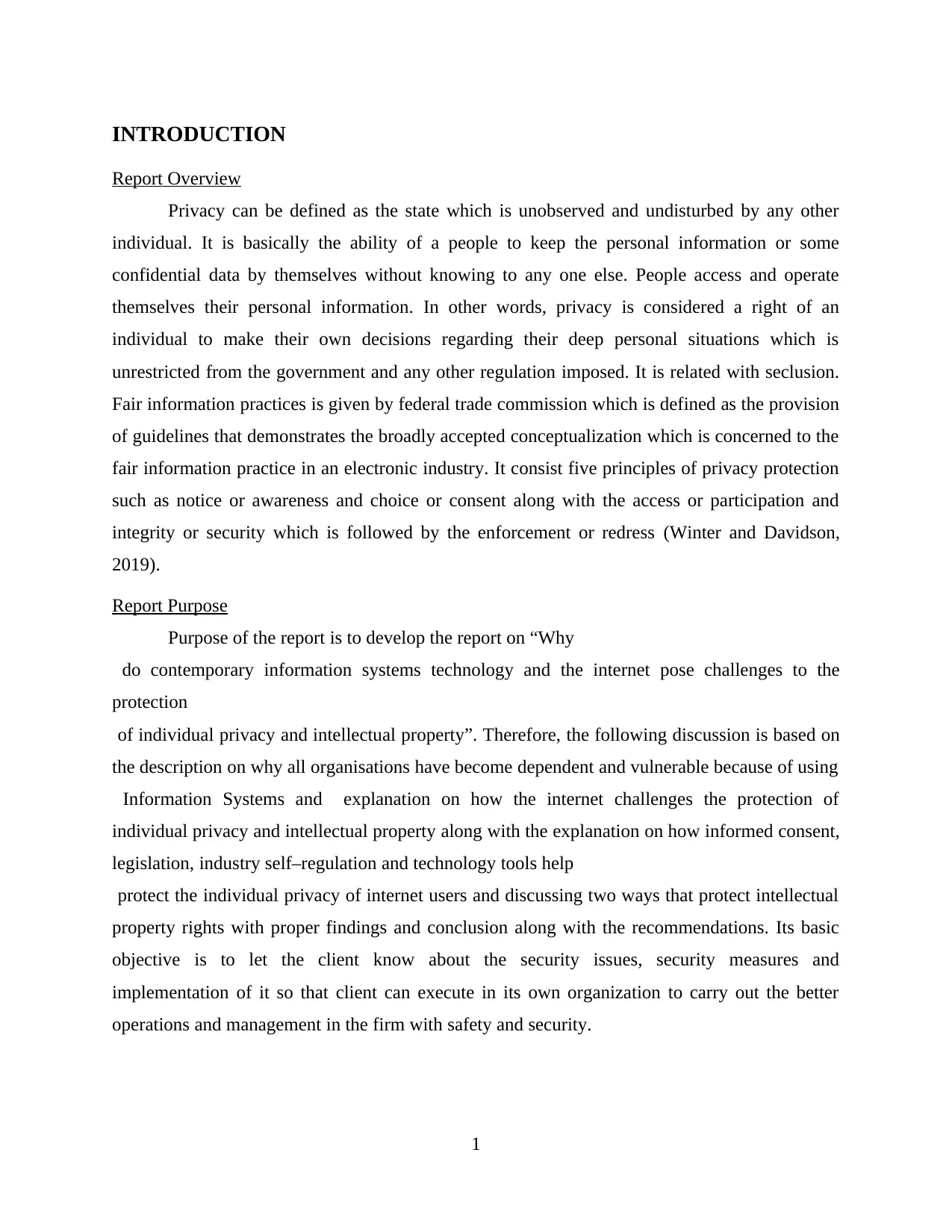
INTRODUCTION
Report Overview
Privacy can be defined as the state which is unobserved and undisturbed by any other
individual. It is basically the ability of a people to keep the personal information or some
confidential data by themselves without knowing to any one else. People access and operate
themselves their personal information. In other words, privacy is considered a right of an
individual to make their own decisions regarding their deep personal situations which is
unrestricted from the government and any other regulation imposed. It is related with seclusion.
Fair information practices is given by federal trade commission which is defined as the provision
of guidelines that demonstrates the broadly accepted conceptualization which is concerned to the
fair information practice in an electronic industry. It consist five principles of privacy protection
such as notice or awareness and choice or consent along with the access or participation and
integrity or security which is followed by the enforcement or redress (Winter and Davidson,
2019).
Report Purpose
Purpose of the report is to develop the report on “Why
do contemporary information systems technology and the internet pose challenges to the
protection
of individual privacy and intellectual property”. Therefore, the following discussion is based on
the description on why all organisations have become dependent and vulnerable because of using
Information Systems and explanation on how the internet challenges the protection of
individual privacy and intellectual property along with the explanation on how informed consent,
legislation, industry self–regulation and technology tools help
protect the individual privacy of internet users and discussing two ways that protect intellectual
property rights with proper findings and conclusion along with the recommendations. Its basic
objective is to let the client know about the security issues, security measures and
implementation of it so that client can execute in its own organization to carry out the better
operations and management in the firm with safety and security.
1
Report Overview
Privacy can be defined as the state which is unobserved and undisturbed by any other
individual. It is basically the ability of a people to keep the personal information or some
confidential data by themselves without knowing to any one else. People access and operate
themselves their personal information. In other words, privacy is considered a right of an
individual to make their own decisions regarding their deep personal situations which is
unrestricted from the government and any other regulation imposed. It is related with seclusion.
Fair information practices is given by federal trade commission which is defined as the provision
of guidelines that demonstrates the broadly accepted conceptualization which is concerned to the
fair information practice in an electronic industry. It consist five principles of privacy protection
such as notice or awareness and choice or consent along with the access or participation and
integrity or security which is followed by the enforcement or redress (Winter and Davidson,
2019).
Report Purpose
Purpose of the report is to develop the report on “Why
do contemporary information systems technology and the internet pose challenges to the
protection
of individual privacy and intellectual property”. Therefore, the following discussion is based on
the description on why all organisations have become dependent and vulnerable because of using
Information Systems and explanation on how the internet challenges the protection of
individual privacy and intellectual property along with the explanation on how informed consent,
legislation, industry self–regulation and technology tools help
protect the individual privacy of internet users and discussing two ways that protect intellectual
property rights with proper findings and conclusion along with the recommendations. Its basic
objective is to let the client know about the security issues, security measures and
implementation of it so that client can execute in its own organization to carry out the better
operations and management in the firm with safety and security.
1
⊘ This is a preview!⊘
Do you want full access?
Subscribe today to unlock all pages.

Trusted by 1+ million students worldwide
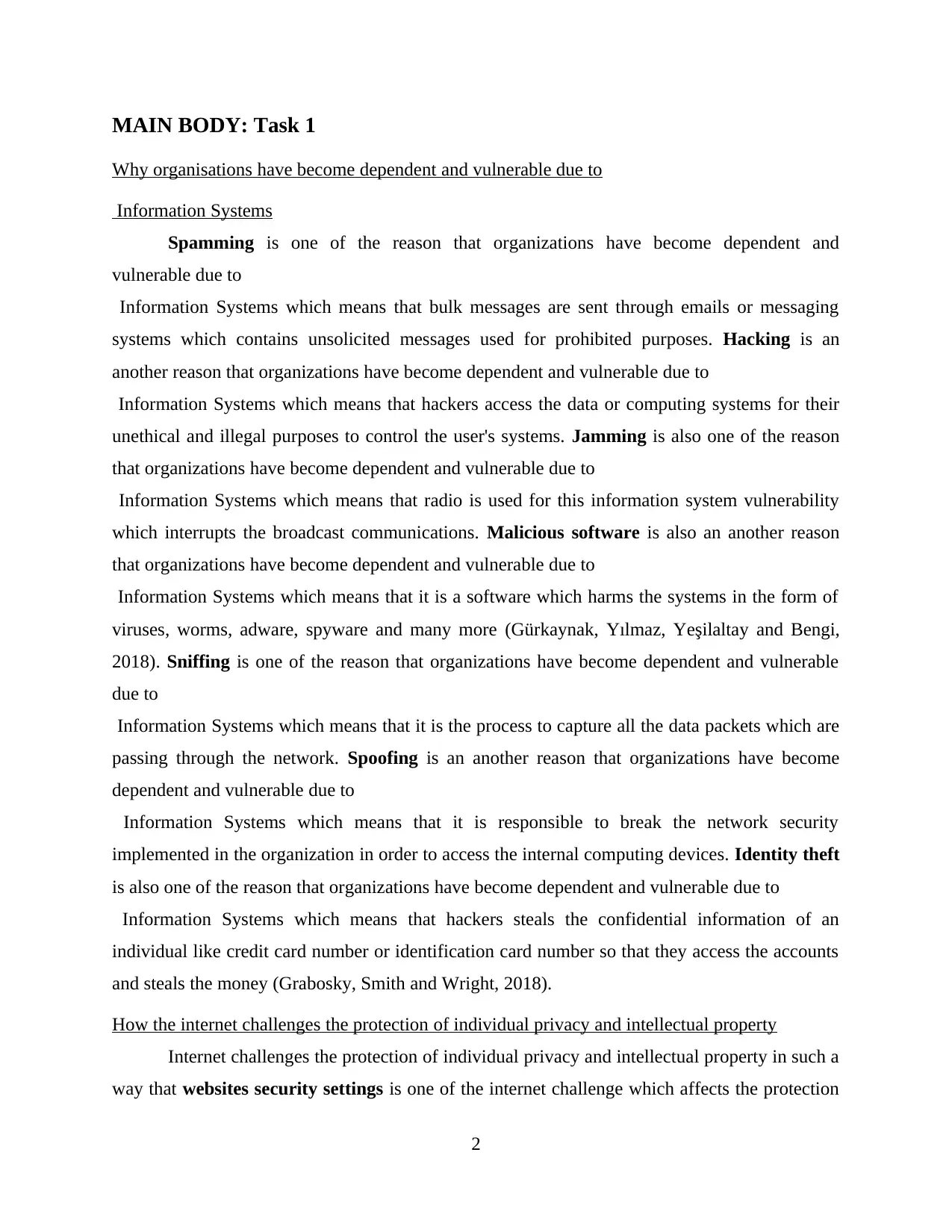
MAIN BODY: Task 1
Why organisations have become dependent and vulnerable due to
Information Systems
Spamming is one of the reason that organizations have become dependent and
vulnerable due to
Information Systems which means that bulk messages are sent through emails or messaging
systems which contains unsolicited messages used for prohibited purposes. Hacking is an
another reason that organizations have become dependent and vulnerable due to
Information Systems which means that hackers access the data or computing systems for their
unethical and illegal purposes to control the user's systems. Jamming is also one of the reason
that organizations have become dependent and vulnerable due to
Information Systems which means that radio is used for this information system vulnerability
which interrupts the broadcast communications. Malicious software is also an another reason
that organizations have become dependent and vulnerable due to
Information Systems which means that it is a software which harms the systems in the form of
viruses, worms, adware, spyware and many more (Gürkaynak, Yılmaz, Yeşilaltay and Bengi,
2018). Sniffing is one of the reason that organizations have become dependent and vulnerable
due to
Information Systems which means that it is the process to capture all the data packets which are
passing through the network. Spoofing is an another reason that organizations have become
dependent and vulnerable due to
Information Systems which means that it is responsible to break the network security
implemented in the organization in order to access the internal computing devices. Identity theft
is also one of the reason that organizations have become dependent and vulnerable due to
Information Systems which means that hackers steals the confidential information of an
individual like credit card number or identification card number so that they access the accounts
and steals the money (Grabosky, Smith and Wright, 2018).
How the internet challenges the protection of individual privacy and intellectual property
Internet challenges the protection of individual privacy and intellectual property in such a
way that websites security settings is one of the internet challenge which affects the protection
2
Why organisations have become dependent and vulnerable due to
Information Systems
Spamming is one of the reason that organizations have become dependent and
vulnerable due to
Information Systems which means that bulk messages are sent through emails or messaging
systems which contains unsolicited messages used for prohibited purposes. Hacking is an
another reason that organizations have become dependent and vulnerable due to
Information Systems which means that hackers access the data or computing systems for their
unethical and illegal purposes to control the user's systems. Jamming is also one of the reason
that organizations have become dependent and vulnerable due to
Information Systems which means that radio is used for this information system vulnerability
which interrupts the broadcast communications. Malicious software is also an another reason
that organizations have become dependent and vulnerable due to
Information Systems which means that it is a software which harms the systems in the form of
viruses, worms, adware, spyware and many more (Gürkaynak, Yılmaz, Yeşilaltay and Bengi,
2018). Sniffing is one of the reason that organizations have become dependent and vulnerable
due to
Information Systems which means that it is the process to capture all the data packets which are
passing through the network. Spoofing is an another reason that organizations have become
dependent and vulnerable due to
Information Systems which means that it is responsible to break the network security
implemented in the organization in order to access the internal computing devices. Identity theft
is also one of the reason that organizations have become dependent and vulnerable due to
Information Systems which means that hackers steals the confidential information of an
individual like credit card number or identification card number so that they access the accounts
and steals the money (Grabosky, Smith and Wright, 2018).
How the internet challenges the protection of individual privacy and intellectual property
Internet challenges the protection of individual privacy and intellectual property in such a
way that websites security settings is one of the internet challenge which affects the protection
2
Paraphrase This Document
Need a fresh take? Get an instant paraphrase of this document with our AI Paraphraser
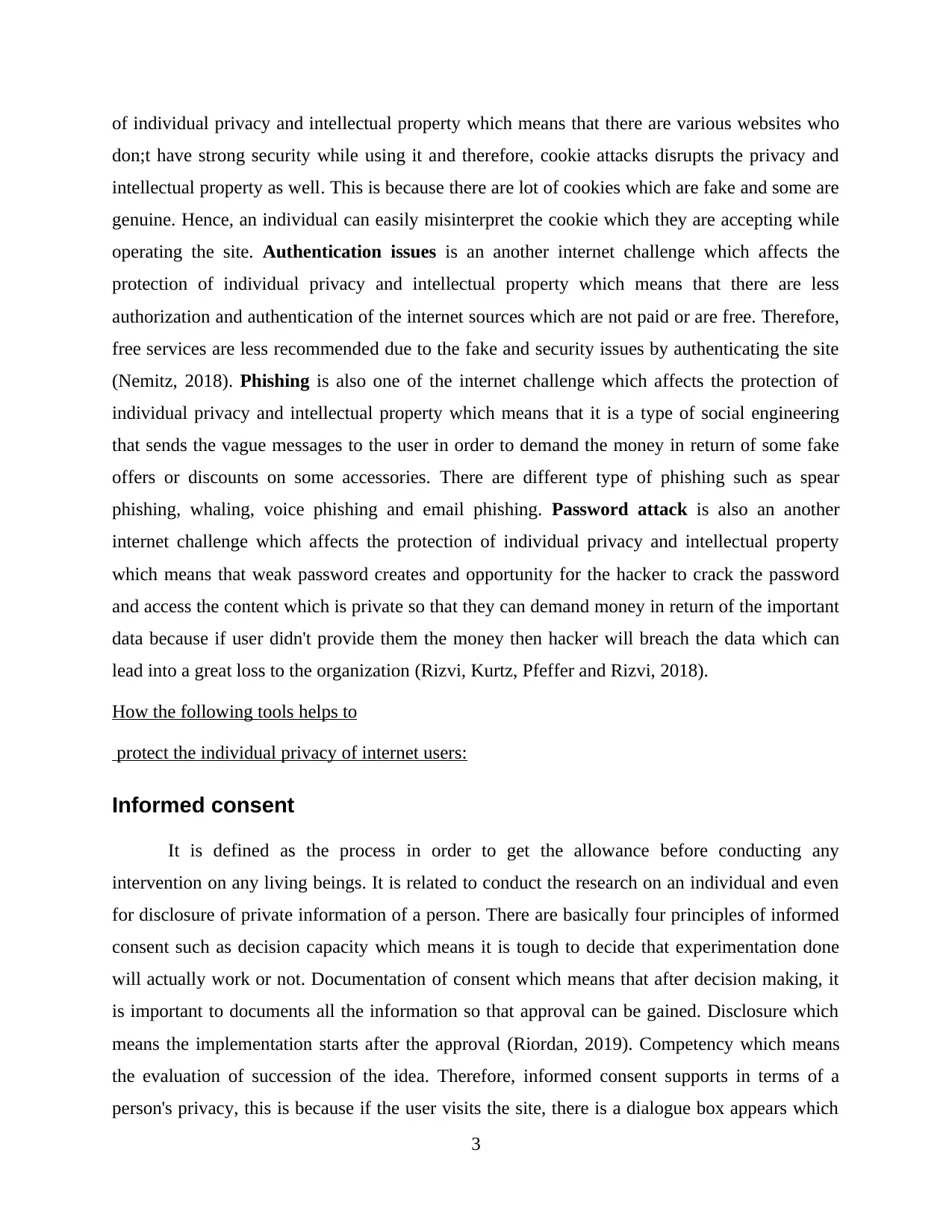
of individual privacy and intellectual property which means that there are various websites who
don;t have strong security while using it and therefore, cookie attacks disrupts the privacy and
intellectual property as well. This is because there are lot of cookies which are fake and some are
genuine. Hence, an individual can easily misinterpret the cookie which they are accepting while
operating the site. Authentication issues is an another internet challenge which affects the
protection of individual privacy and intellectual property which means that there are less
authorization and authentication of the internet sources which are not paid or are free. Therefore,
free services are less recommended due to the fake and security issues by authenticating the site
(Nemitz, 2018). Phishing is also one of the internet challenge which affects the protection of
individual privacy and intellectual property which means that it is a type of social engineering
that sends the vague messages to the user in order to demand the money in return of some fake
offers or discounts on some accessories. There are different type of phishing such as spear
phishing, whaling, voice phishing and email phishing. Password attack is also an another
internet challenge which affects the protection of individual privacy and intellectual property
which means that weak password creates and opportunity for the hacker to crack the password
and access the content which is private so that they can demand money in return of the important
data because if user didn't provide them the money then hacker will breach the data which can
lead into a great loss to the organization (Rizvi, Kurtz, Pfeffer and Rizvi, 2018).
How the following tools helps to
protect the individual privacy of internet users:
Informed consent
It is defined as the process in order to get the allowance before conducting any
intervention on any living beings. It is related to conduct the research on an individual and even
for disclosure of private information of a person. There are basically four principles of informed
consent such as decision capacity which means it is tough to decide that experimentation done
will actually work or not. Documentation of consent which means that after decision making, it
is important to documents all the information so that approval can be gained. Disclosure which
means the implementation starts after the approval (Riordan, 2019). Competency which means
the evaluation of succession of the idea. Therefore, informed consent supports in terms of a
person's privacy, this is because if the user visits the site, there is a dialogue box appears which
3
don;t have strong security while using it and therefore, cookie attacks disrupts the privacy and
intellectual property as well. This is because there are lot of cookies which are fake and some are
genuine. Hence, an individual can easily misinterpret the cookie which they are accepting while
operating the site. Authentication issues is an another internet challenge which affects the
protection of individual privacy and intellectual property which means that there are less
authorization and authentication of the internet sources which are not paid or are free. Therefore,
free services are less recommended due to the fake and security issues by authenticating the site
(Nemitz, 2018). Phishing is also one of the internet challenge which affects the protection of
individual privacy and intellectual property which means that it is a type of social engineering
that sends the vague messages to the user in order to demand the money in return of some fake
offers or discounts on some accessories. There are different type of phishing such as spear
phishing, whaling, voice phishing and email phishing. Password attack is also an another
internet challenge which affects the protection of individual privacy and intellectual property
which means that weak password creates and opportunity for the hacker to crack the password
and access the content which is private so that they can demand money in return of the important
data because if user didn't provide them the money then hacker will breach the data which can
lead into a great loss to the organization (Rizvi, Kurtz, Pfeffer and Rizvi, 2018).
How the following tools helps to
protect the individual privacy of internet users:
Informed consent
It is defined as the process in order to get the allowance before conducting any
intervention on any living beings. It is related to conduct the research on an individual and even
for disclosure of private information of a person. There are basically four principles of informed
consent such as decision capacity which means it is tough to decide that experimentation done
will actually work or not. Documentation of consent which means that after decision making, it
is important to documents all the information so that approval can be gained. Disclosure which
means the implementation starts after the approval (Riordan, 2019). Competency which means
the evaluation of succession of the idea. Therefore, informed consent supports in terms of a
person's privacy, this is because if the user visits the site, there is a dialogue box appears which
3
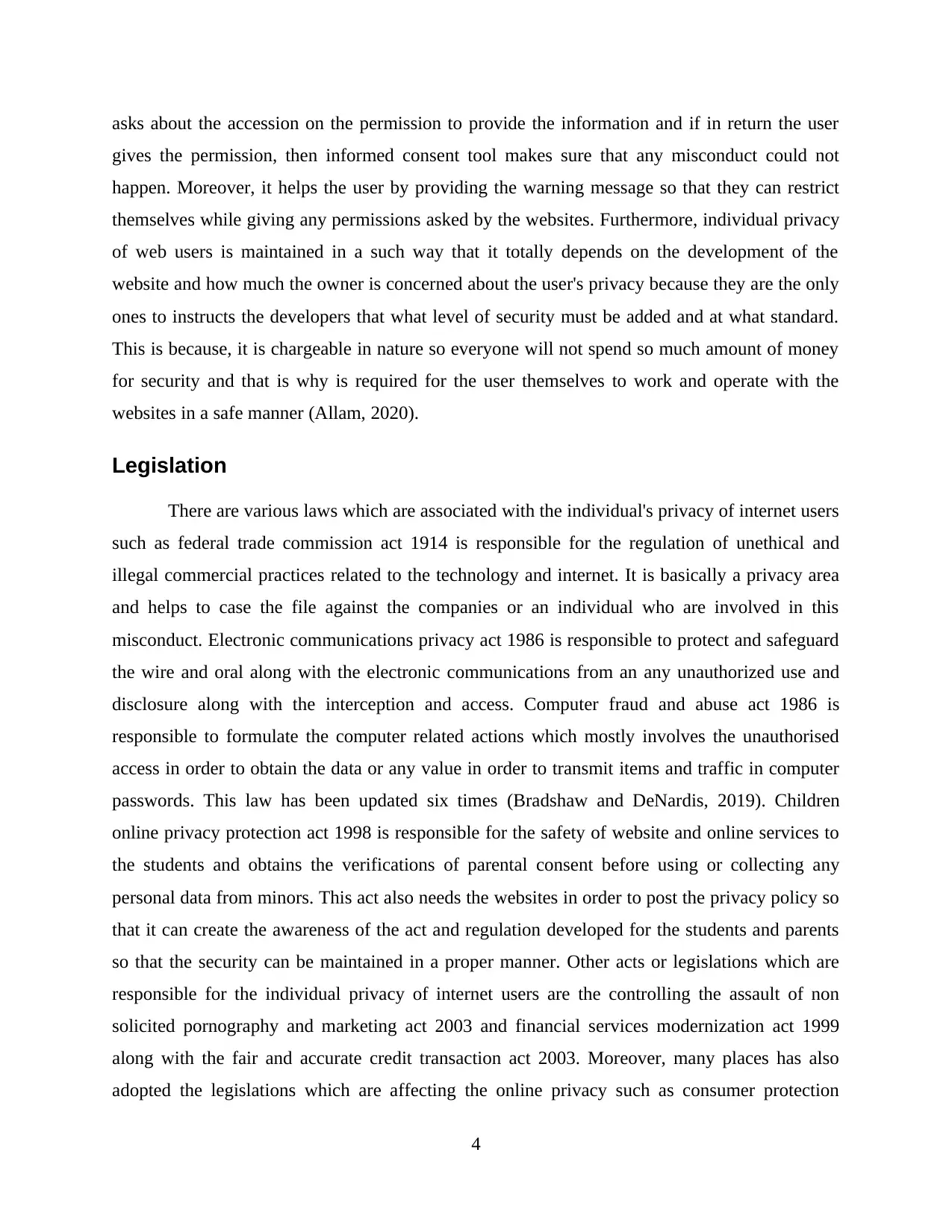
asks about the accession on the permission to provide the information and if in return the user
gives the permission, then informed consent tool makes sure that any misconduct could not
happen. Moreover, it helps the user by providing the warning message so that they can restrict
themselves while giving any permissions asked by the websites. Furthermore, individual privacy
of web users is maintained in a such way that it totally depends on the development of the
website and how much the owner is concerned about the user's privacy because they are the only
ones to instructs the developers that what level of security must be added and at what standard.
This is because, it is chargeable in nature so everyone will not spend so much amount of money
for security and that is why is required for the user themselves to work and operate with the
websites in a safe manner (Allam, 2020).
Legislation
There are various laws which are associated with the individual's privacy of internet users
such as federal trade commission act 1914 is responsible for the regulation of unethical and
illegal commercial practices related to the technology and internet. It is basically a privacy area
and helps to case the file against the companies or an individual who are involved in this
misconduct. Electronic communications privacy act 1986 is responsible to protect and safeguard
the wire and oral along with the electronic communications from an any unauthorized use and
disclosure along with the interception and access. Computer fraud and abuse act 1986 is
responsible to formulate the computer related actions which mostly involves the unauthorised
access in order to obtain the data or any value in order to transmit items and traffic in computer
passwords. This law has been updated six times (Bradshaw and DeNardis, 2019). Children
online privacy protection act 1998 is responsible for the safety of website and online services to
the students and obtains the verifications of parental consent before using or collecting any
personal data from minors. This act also needs the websites in order to post the privacy policy so
that it can create the awareness of the act and regulation developed for the students and parents
so that the security can be maintained in a proper manner. Other acts or legislations which are
responsible for the individual privacy of internet users are the controlling the assault of non
solicited pornography and marketing act 2003 and financial services modernization act 1999
along with the fair and accurate credit transaction act 2003. Moreover, many places has also
adopted the legislations which are affecting the online privacy such as consumer protection
4
gives the permission, then informed consent tool makes sure that any misconduct could not
happen. Moreover, it helps the user by providing the warning message so that they can restrict
themselves while giving any permissions asked by the websites. Furthermore, individual privacy
of web users is maintained in a such way that it totally depends on the development of the
website and how much the owner is concerned about the user's privacy because they are the only
ones to instructs the developers that what level of security must be added and at what standard.
This is because, it is chargeable in nature so everyone will not spend so much amount of money
for security and that is why is required for the user themselves to work and operate with the
websites in a safe manner (Allam, 2020).
Legislation
There are various laws which are associated with the individual's privacy of internet users
such as federal trade commission act 1914 is responsible for the regulation of unethical and
illegal commercial practices related to the technology and internet. It is basically a privacy area
and helps to case the file against the companies or an individual who are involved in this
misconduct. Electronic communications privacy act 1986 is responsible to protect and safeguard
the wire and oral along with the electronic communications from an any unauthorized use and
disclosure along with the interception and access. Computer fraud and abuse act 1986 is
responsible to formulate the computer related actions which mostly involves the unauthorised
access in order to obtain the data or any value in order to transmit items and traffic in computer
passwords. This law has been updated six times (Bradshaw and DeNardis, 2019). Children
online privacy protection act 1998 is responsible for the safety of website and online services to
the students and obtains the verifications of parental consent before using or collecting any
personal data from minors. This act also needs the websites in order to post the privacy policy so
that it can create the awareness of the act and regulation developed for the students and parents
so that the security can be maintained in a proper manner. Other acts or legislations which are
responsible for the individual privacy of internet users are the controlling the assault of non
solicited pornography and marketing act 2003 and financial services modernization act 1999
along with the fair and accurate credit transaction act 2003. Moreover, many places has also
adopted the legislations which are affecting the online privacy such as consumer protection
4
⊘ This is a preview!⊘
Do you want full access?
Subscribe today to unlock all pages.

Trusted by 1+ million students worldwide
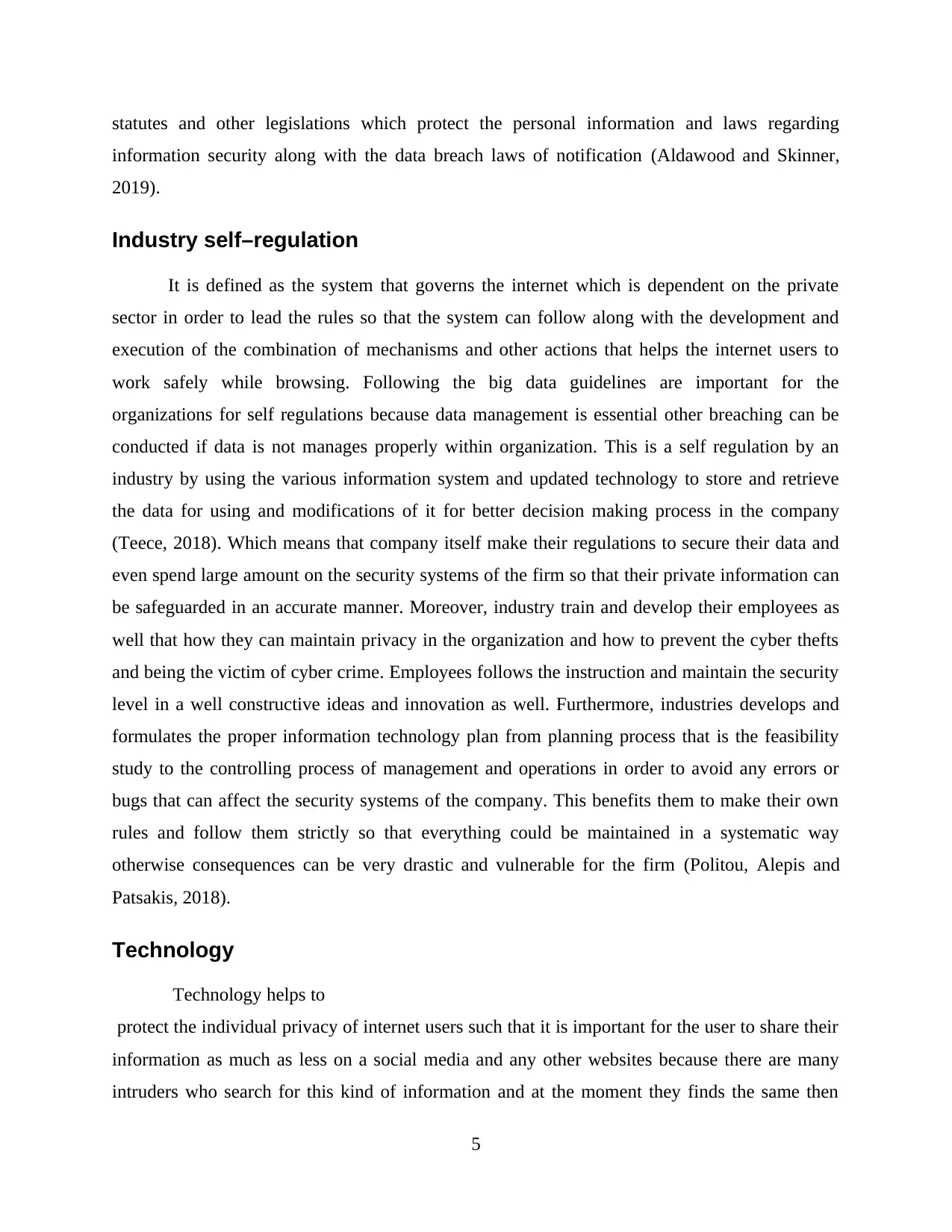
statutes and other legislations which protect the personal information and laws regarding
information security along with the data breach laws of notification (Aldawood and Skinner,
2019).
Industry self–regulation
It is defined as the system that governs the internet which is dependent on the private
sector in order to lead the rules so that the system can follow along with the development and
execution of the combination of mechanisms and other actions that helps the internet users to
work safely while browsing. Following the big data guidelines are important for the
organizations for self regulations because data management is essential other breaching can be
conducted if data is not manages properly within organization. This is a self regulation by an
industry by using the various information system and updated technology to store and retrieve
the data for using and modifications of it for better decision making process in the company
(Teece, 2018). Which means that company itself make their regulations to secure their data and
even spend large amount on the security systems of the firm so that their private information can
be safeguarded in an accurate manner. Moreover, industry train and develop their employees as
well that how they can maintain privacy in the organization and how to prevent the cyber thefts
and being the victim of cyber crime. Employees follows the instruction and maintain the security
level in a well constructive ideas and innovation as well. Furthermore, industries develops and
formulates the proper information technology plan from planning process that is the feasibility
study to the controlling process of management and operations in order to avoid any errors or
bugs that can affect the security systems of the company. This benefits them to make their own
rules and follow them strictly so that everything could be maintained in a systematic way
otherwise consequences can be very drastic and vulnerable for the firm (Politou, Alepis and
Patsakis, 2018).
Technology
Technology helps to
protect the individual privacy of internet users such that it is important for the user to share their
information as much as less on a social media and any other websites because there are many
intruders who search for this kind of information and at the moment they finds the same then
5
information security along with the data breach laws of notification (Aldawood and Skinner,
2019).
Industry self–regulation
It is defined as the system that governs the internet which is dependent on the private
sector in order to lead the rules so that the system can follow along with the development and
execution of the combination of mechanisms and other actions that helps the internet users to
work safely while browsing. Following the big data guidelines are important for the
organizations for self regulations because data management is essential other breaching can be
conducted if data is not manages properly within organization. This is a self regulation by an
industry by using the various information system and updated technology to store and retrieve
the data for using and modifications of it for better decision making process in the company
(Teece, 2018). Which means that company itself make their regulations to secure their data and
even spend large amount on the security systems of the firm so that their private information can
be safeguarded in an accurate manner. Moreover, industry train and develop their employees as
well that how they can maintain privacy in the organization and how to prevent the cyber thefts
and being the victim of cyber crime. Employees follows the instruction and maintain the security
level in a well constructive ideas and innovation as well. Furthermore, industries develops and
formulates the proper information technology plan from planning process that is the feasibility
study to the controlling process of management and operations in order to avoid any errors or
bugs that can affect the security systems of the company. This benefits them to make their own
rules and follow them strictly so that everything could be maintained in a systematic way
otherwise consequences can be very drastic and vulnerable for the firm (Politou, Alepis and
Patsakis, 2018).
Technology
Technology helps to
protect the individual privacy of internet users such that it is important for the user to share their
information as much as less on a social media and any other websites because there are many
intruders who search for this kind of information and at the moment they finds the same then
5
Paraphrase This Document
Need a fresh take? Get an instant paraphrase of this document with our AI Paraphraser
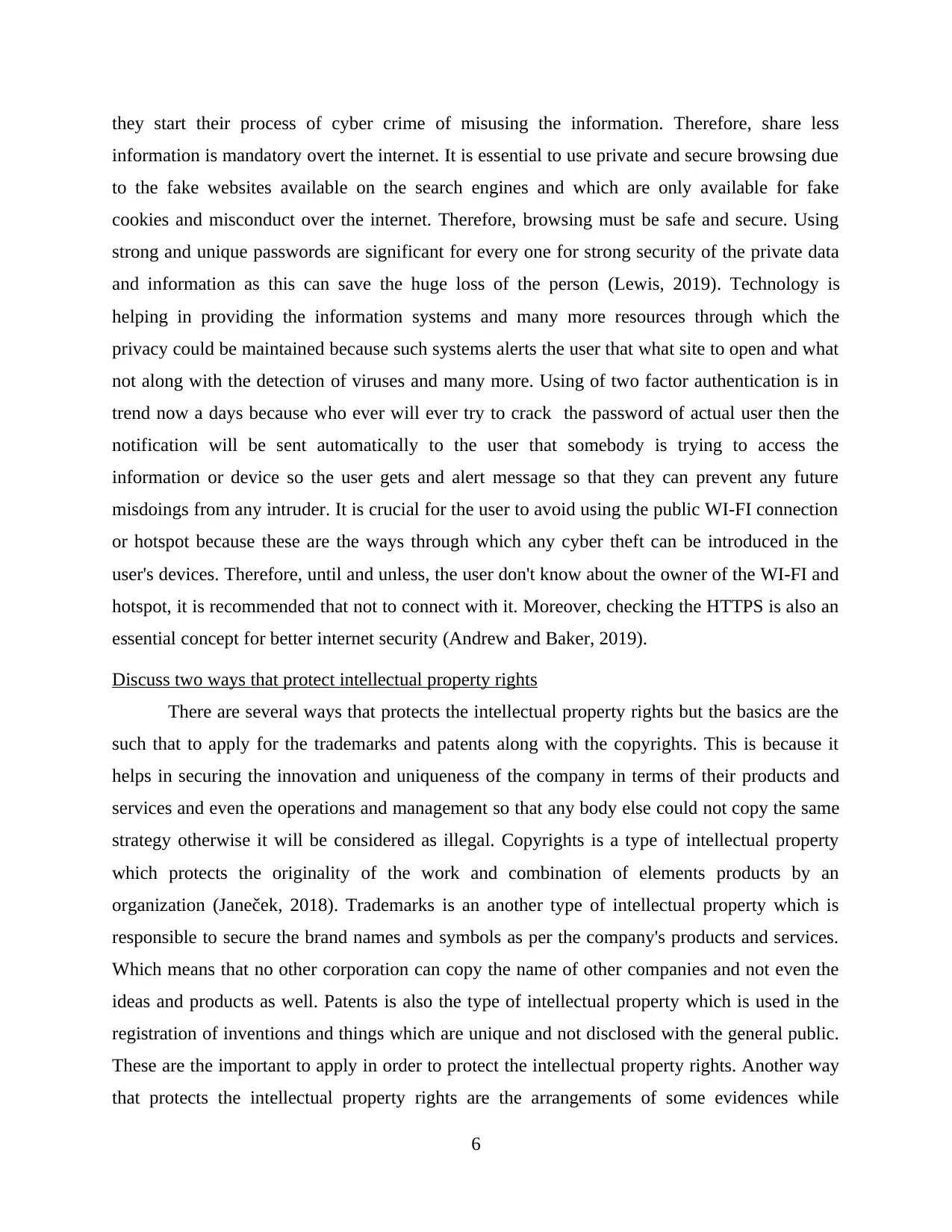
they start their process of cyber crime of misusing the information. Therefore, share less
information is mandatory overt the internet. It is essential to use private and secure browsing due
to the fake websites available on the search engines and which are only available for fake
cookies and misconduct over the internet. Therefore, browsing must be safe and secure. Using
strong and unique passwords are significant for every one for strong security of the private data
and information as this can save the huge loss of the person (Lewis, 2019). Technology is
helping in providing the information systems and many more resources through which the
privacy could be maintained because such systems alerts the user that what site to open and what
not along with the detection of viruses and many more. Using of two factor authentication is in
trend now a days because who ever will ever try to crack the password of actual user then the
notification will be sent automatically to the user that somebody is trying to access the
information or device so the user gets and alert message so that they can prevent any future
misdoings from any intruder. It is crucial for the user to avoid using the public WI-FI connection
or hotspot because these are the ways through which any cyber theft can be introduced in the
user's devices. Therefore, until and unless, the user don't know about the owner of the WI-FI and
hotspot, it is recommended that not to connect with it. Moreover, checking the HTTPS is also an
essential concept for better internet security (Andrew and Baker, 2019).
Discuss two ways that protect intellectual property rights
There are several ways that protects the intellectual property rights but the basics are the
such that to apply for the trademarks and patents along with the copyrights. This is because it
helps in securing the innovation and uniqueness of the company in terms of their products and
services and even the operations and management so that any body else could not copy the same
strategy otherwise it will be considered as illegal. Copyrights is a type of intellectual property
which protects the originality of the work and combination of elements products by an
organization (Janeček, 2018). Trademarks is an another type of intellectual property which is
responsible to secure the brand names and symbols as per the company's products and services.
Which means that no other corporation can copy the name of other companies and not even the
ideas and products as well. Patents is also the type of intellectual property which is used in the
registration of inventions and things which are unique and not disclosed with the general public.
These are the important to apply in order to protect the intellectual property rights. Another way
that protects the intellectual property rights are the arrangements of some evidences while
6
information is mandatory overt the internet. It is essential to use private and secure browsing due
to the fake websites available on the search engines and which are only available for fake
cookies and misconduct over the internet. Therefore, browsing must be safe and secure. Using
strong and unique passwords are significant for every one for strong security of the private data
and information as this can save the huge loss of the person (Lewis, 2019). Technology is
helping in providing the information systems and many more resources through which the
privacy could be maintained because such systems alerts the user that what site to open and what
not along with the detection of viruses and many more. Using of two factor authentication is in
trend now a days because who ever will ever try to crack the password of actual user then the
notification will be sent automatically to the user that somebody is trying to access the
information or device so the user gets and alert message so that they can prevent any future
misdoings from any intruder. It is crucial for the user to avoid using the public WI-FI connection
or hotspot because these are the ways through which any cyber theft can be introduced in the
user's devices. Therefore, until and unless, the user don't know about the owner of the WI-FI and
hotspot, it is recommended that not to connect with it. Moreover, checking the HTTPS is also an
essential concept for better internet security (Andrew and Baker, 2019).
Discuss two ways that protect intellectual property rights
There are several ways that protects the intellectual property rights but the basics are the
such that to apply for the trademarks and patents along with the copyrights. This is because it
helps in securing the innovation and uniqueness of the company in terms of their products and
services and even the operations and management so that any body else could not copy the same
strategy otherwise it will be considered as illegal. Copyrights is a type of intellectual property
which protects the originality of the work and combination of elements products by an
organization (Janeček, 2018). Trademarks is an another type of intellectual property which is
responsible to secure the brand names and symbols as per the company's products and services.
Which means that no other corporation can copy the name of other companies and not even the
ideas and products as well. Patents is also the type of intellectual property which is used in the
registration of inventions and things which are unique and not disclosed with the general public.
These are the important to apply in order to protect the intellectual property rights. Another way
that protects the intellectual property rights are the arrangements of some evidences while
6
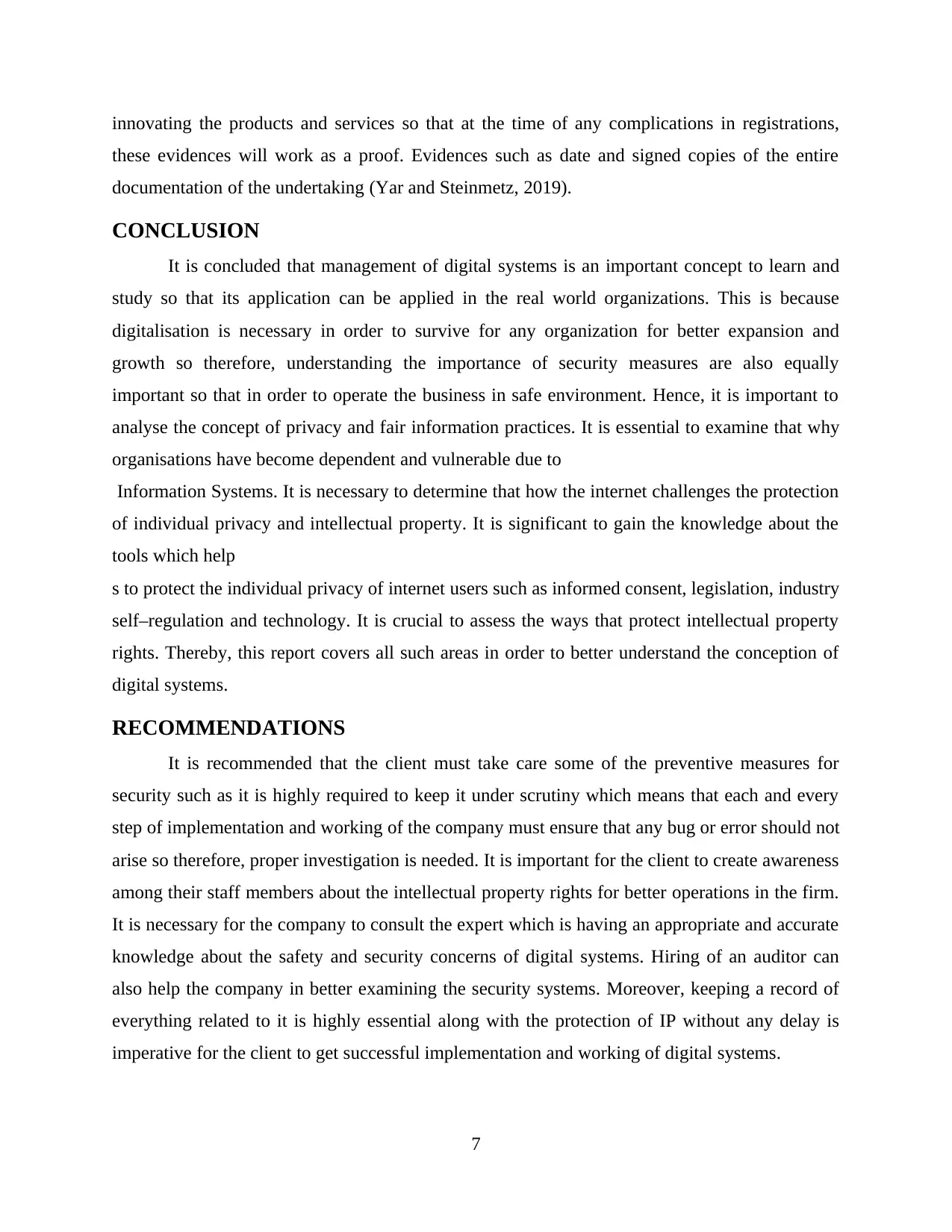
innovating the products and services so that at the time of any complications in registrations,
these evidences will work as a proof. Evidences such as date and signed copies of the entire
documentation of the undertaking (Yar and Steinmetz, 2019).
CONCLUSION
It is concluded that management of digital systems is an important concept to learn and
study so that its application can be applied in the real world organizations. This is because
digitalisation is necessary in order to survive for any organization for better expansion and
growth so therefore, understanding the importance of security measures are also equally
important so that in order to operate the business in safe environment. Hence, it is important to
analyse the concept of privacy and fair information practices. It is essential to examine that why
organisations have become dependent and vulnerable due to
Information Systems. It is necessary to determine that how the internet challenges the protection
of individual privacy and intellectual property. It is significant to gain the knowledge about the
tools which help
s to protect the individual privacy of internet users such as informed consent, legislation, industry
self–regulation and technology. It is crucial to assess the ways that protect intellectual property
rights. Thereby, this report covers all such areas in order to better understand the conception of
digital systems.
RECOMMENDATIONS
It is recommended that the client must take care some of the preventive measures for
security such as it is highly required to keep it under scrutiny which means that each and every
step of implementation and working of the company must ensure that any bug or error should not
arise so therefore, proper investigation is needed. It is important for the client to create awareness
among their staff members about the intellectual property rights for better operations in the firm.
It is necessary for the company to consult the expert which is having an appropriate and accurate
knowledge about the safety and security concerns of digital systems. Hiring of an auditor can
also help the company in better examining the security systems. Moreover, keeping a record of
everything related to it is highly essential along with the protection of IP without any delay is
imperative for the client to get successful implementation and working of digital systems.
7
these evidences will work as a proof. Evidences such as date and signed copies of the entire
documentation of the undertaking (Yar and Steinmetz, 2019).
CONCLUSION
It is concluded that management of digital systems is an important concept to learn and
study so that its application can be applied in the real world organizations. This is because
digitalisation is necessary in order to survive for any organization for better expansion and
growth so therefore, understanding the importance of security measures are also equally
important so that in order to operate the business in safe environment. Hence, it is important to
analyse the concept of privacy and fair information practices. It is essential to examine that why
organisations have become dependent and vulnerable due to
Information Systems. It is necessary to determine that how the internet challenges the protection
of individual privacy and intellectual property. It is significant to gain the knowledge about the
tools which help
s to protect the individual privacy of internet users such as informed consent, legislation, industry
self–regulation and technology. It is crucial to assess the ways that protect intellectual property
rights. Thereby, this report covers all such areas in order to better understand the conception of
digital systems.
RECOMMENDATIONS
It is recommended that the client must take care some of the preventive measures for
security such as it is highly required to keep it under scrutiny which means that each and every
step of implementation and working of the company must ensure that any bug or error should not
arise so therefore, proper investigation is needed. It is important for the client to create awareness
among their staff members about the intellectual property rights for better operations in the firm.
It is necessary for the company to consult the expert which is having an appropriate and accurate
knowledge about the safety and security concerns of digital systems. Hiring of an auditor can
also help the company in better examining the security systems. Moreover, keeping a record of
everything related to it is highly essential along with the protection of IP without any delay is
imperative for the client to get successful implementation and working of digital systems.
7
⊘ This is a preview!⊘
Do you want full access?
Subscribe today to unlock all pages.

Trusted by 1+ million students worldwide
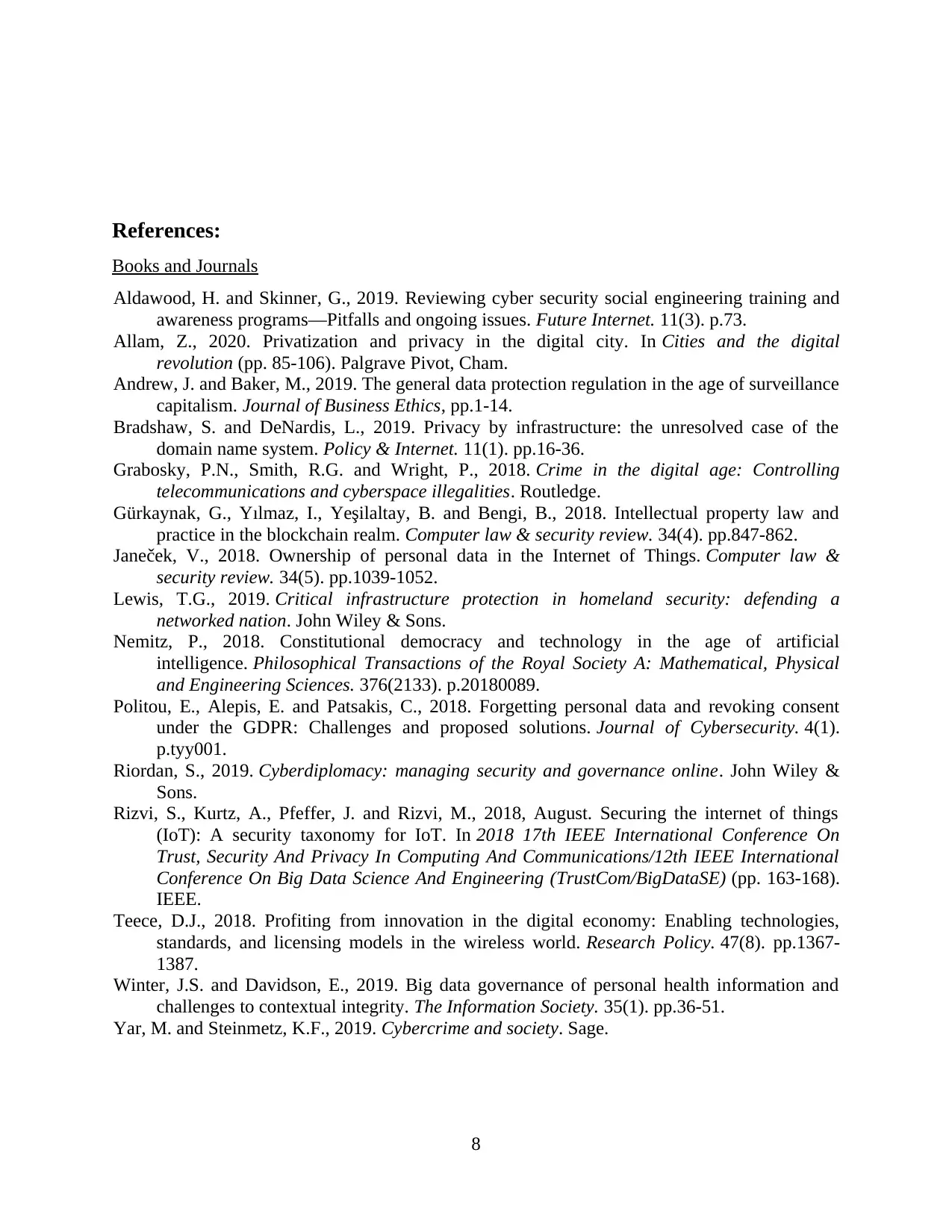
References:
Books and Journals
Aldawood, H. and Skinner, G., 2019. Reviewing cyber security social engineering training and
awareness programs—Pitfalls and ongoing issues. Future Internet. 11(3). p.73.
Allam, Z., 2020. Privatization and privacy in the digital city. In Cities and the digital
revolution (pp. 85-106). Palgrave Pivot, Cham.
Andrew, J. and Baker, M., 2019. The general data protection regulation in the age of surveillance
capitalism. Journal of Business Ethics, pp.1-14.
Bradshaw, S. and DeNardis, L., 2019. Privacy by infrastructure: the unresolved case of the
domain name system. Policy & Internet. 11(1). pp.16-36.
Grabosky, P.N., Smith, R.G. and Wright, P., 2018. Crime in the digital age: Controlling
telecommunications and cyberspace illegalities. Routledge.
Gürkaynak, G., Yılmaz, I., Yeşilaltay, B. and Bengi, B., 2018. Intellectual property law and
practice in the blockchain realm. Computer law & security review. 34(4). pp.847-862.
Janeček, V., 2018. Ownership of personal data in the Internet of Things. Computer law &
security review. 34(5). pp.1039-1052.
Lewis, T.G., 2019. Critical infrastructure protection in homeland security: defending a
networked nation. John Wiley & Sons.
Nemitz, P., 2018. Constitutional democracy and technology in the age of artificial
intelligence. Philosophical Transactions of the Royal Society A: Mathematical, Physical
and Engineering Sciences. 376(2133). p.20180089.
Politou, E., Alepis, E. and Patsakis, C., 2018. Forgetting personal data and revoking consent
under the GDPR: Challenges and proposed solutions. Journal of Cybersecurity. 4(1).
p.tyy001.
Riordan, S., 2019. Cyberdiplomacy: managing security and governance online. John Wiley &
Sons.
Rizvi, S., Kurtz, A., Pfeffer, J. and Rizvi, M., 2018, August. Securing the internet of things
(IoT): A security taxonomy for IoT. In 2018 17th IEEE International Conference On
Trust, Security And Privacy In Computing And Communications/12th IEEE International
Conference On Big Data Science And Engineering (TrustCom/BigDataSE) (pp. 163-168).
IEEE.
Teece, D.J., 2018. Profiting from innovation in the digital economy: Enabling technologies,
standards, and licensing models in the wireless world. Research Policy. 47(8). pp.1367-
1387.
Winter, J.S. and Davidson, E., 2019. Big data governance of personal health information and
challenges to contextual integrity. The Information Society. 35(1). pp.36-51.
Yar, M. and Steinmetz, K.F., 2019. Cybercrime and society. Sage.
8
Books and Journals
Aldawood, H. and Skinner, G., 2019. Reviewing cyber security social engineering training and
awareness programs—Pitfalls and ongoing issues. Future Internet. 11(3). p.73.
Allam, Z., 2020. Privatization and privacy in the digital city. In Cities and the digital
revolution (pp. 85-106). Palgrave Pivot, Cham.
Andrew, J. and Baker, M., 2019. The general data protection regulation in the age of surveillance
capitalism. Journal of Business Ethics, pp.1-14.
Bradshaw, S. and DeNardis, L., 2019. Privacy by infrastructure: the unresolved case of the
domain name system. Policy & Internet. 11(1). pp.16-36.
Grabosky, P.N., Smith, R.G. and Wright, P., 2018. Crime in the digital age: Controlling
telecommunications and cyberspace illegalities. Routledge.
Gürkaynak, G., Yılmaz, I., Yeşilaltay, B. and Bengi, B., 2018. Intellectual property law and
practice in the blockchain realm. Computer law & security review. 34(4). pp.847-862.
Janeček, V., 2018. Ownership of personal data in the Internet of Things. Computer law &
security review. 34(5). pp.1039-1052.
Lewis, T.G., 2019. Critical infrastructure protection in homeland security: defending a
networked nation. John Wiley & Sons.
Nemitz, P., 2018. Constitutional democracy and technology in the age of artificial
intelligence. Philosophical Transactions of the Royal Society A: Mathematical, Physical
and Engineering Sciences. 376(2133). p.20180089.
Politou, E., Alepis, E. and Patsakis, C., 2018. Forgetting personal data and revoking consent
under the GDPR: Challenges and proposed solutions. Journal of Cybersecurity. 4(1).
p.tyy001.
Riordan, S., 2019. Cyberdiplomacy: managing security and governance online. John Wiley &
Sons.
Rizvi, S., Kurtz, A., Pfeffer, J. and Rizvi, M., 2018, August. Securing the internet of things
(IoT): A security taxonomy for IoT. In 2018 17th IEEE International Conference On
Trust, Security And Privacy In Computing And Communications/12th IEEE International
Conference On Big Data Science And Engineering (TrustCom/BigDataSE) (pp. 163-168).
IEEE.
Teece, D.J., 2018. Profiting from innovation in the digital economy: Enabling technologies,
standards, and licensing models in the wireless world. Research Policy. 47(8). pp.1367-
1387.
Winter, J.S. and Davidson, E., 2019. Big data governance of personal health information and
challenges to contextual integrity. The Information Society. 35(1). pp.36-51.
Yar, M. and Steinmetz, K.F., 2019. Cybercrime and society. Sage.
8
1 out of 10
Related Documents
Your All-in-One AI-Powered Toolkit for Academic Success.
+13062052269
info@desklib.com
Available 24*7 on WhatsApp / Email
![[object Object]](/_next/static/media/star-bottom.7253800d.svg)
Unlock your academic potential
Copyright © 2020–2025 A2Z Services. All Rights Reserved. Developed and managed by ZUCOL.





